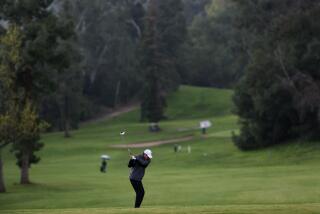Deteriorated During Fiscal Crisis in ‘70s : N.Y. Public Golf Courses Back Up to Par
- Share via
NEW YORK — During New York City’s financial crisis in the 1970s, informal local rule changes were adopted at some municipal golf courses where a shortage of funds resulted in some unusual hazards.
A player was allowed to drop his ball a club length away if it rolled up against an abandoned auto, or, in one case, a boat. To thwart robbers, besieged golfers quit playing in traditional foursomes and instead ventured forth in football-team-sized units. Some players added an extra club--a night stick--or tucked tear gas spray into their golf bags.
Weeds took over sand traps. Golfers arrived at one course to find four persons sleeping in a car in a bunker. Some players wore winter clothes in stifling summer heat because money was lacking to spray regularly for mosquitoes.
Neighborhood youngsters built huts and forts on one course; teen-agers carved out a dirt track for motorbike racing on another. The homeless began to show up as squatters.
A Renaissance
But all that has changed. For New York’s dedicated duffers, the summer of 1985 is shaping up as nothing less than a renaissance.
The key to the turnaround occurred two years ago when the city licensed American Golf Corp., based in Los Angeles, to operate six courses. Even though the company runs 60 golf courses throughout the United States, some of the challenges it faced in New York were unique.
“We found the courses were--how do you put it delicately--in various stages of needing refurbishing,” said Kimble Knowlden, American Golf’s New York regional director. “ . . . We’ve tried to bring California standards to New York courses.”
For some courses, American Golf purchased new maintenance equipment and hired and trained new crews. Basic mowing began. Greens were reseeded, irrigation systems installed, practice areas were built. All told, $1 million in improvements were made.
Marshals Recruited
To thwart crime, senior golfers were recruited to act as marshals and were paid with free rounds of golf.
The first weekend that John DeMatteo, American Golf’s maintenance supervisor, arrived in New York City in August, 1983, the magnitude of what lay ahead became clear to him. DeMatteo traveled to New Jersey to play a round of golf. At the public course where he waited to tee off, he ran into players from South Shore, one of New York’s municipal courses.
“Why aren’t you at South Shore?” DeMatteo asked.
“Are you crazy?” the golfers replied.
South Shore posed extra problems. The well water was so polluted from a nearby landfill that grass turned black when hoses were turned on. The city has since given American Golf permission to use alternative water sources for irrigation there.
Bullies Push Ahead
A lot of the etiquette of the game went out the window when golfers were forced to line up well before dawn for starting times. Bullies pushed ahead of others to tee off or grab golf carts. American Golf solved that problem in May by instituting a phone reservation system.
Alice Donegan, a golfer at Pelham in the Bronx, said: “They’re catering to people who enjoy golf. I think the whole atmosphere has improved.”
“It’s a 150% improvement,” said Toby Laschiver as she fastened her bag onto a new cart. “I have to get used to a good course.”
Generating Income
The courses are now generating income for the city, said Joanne Imohiosen, chief of the revenue division of the Department of Parks and Recreation.
“Some of the people who had gone to Long Island and New Jersey have come back to the city,” she said. The number of golfers on city courses is 68% ahead of last year.
The Parks Department still operates four golf courses, including 90-year-old Van Cortlandt Park in the Bronx, the nation’s first public golf course. But the licensing arrangement has allowed the city to redeploy resources and improve maintenance.
“They (all the courses) are a wonderful resource in the city, these vast stretches of green,” Imohiosen said. “You go out on them and you don’t realize you are in an urban environment. It’s wonderful.”
More to Read
Sign up for Essential California
The most important California stories and recommendations in your inbox every morning.
You may occasionally receive promotional content from the Los Angeles Times.













